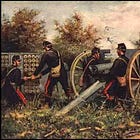According the rating system used by the French Army, the 16th Infantry Division qualified as a ‘category A’ formation. As a result, when it was mobilized at the start of the Second World War, it stood at the front of the queue for professional officers, regular NCOs, and reservists of the youngest classes.
The 16ème Division d’Infanterie also enjoyed a privileged position when it came to the allocation of first-rate weapons. That is, the component units of the organization possessed all of the rifles, machine guns, mortars, and artillery pieces called for by their respective tables of organization and equipment. Indeed, were it not for a shortage of 25mm anti-tank guns, the 16th Infantry Division would have been ‘up to establishment’ in all categories of equipment.
The 16th Infantry Division rated fifty-two 25mm anti-tank guns. Of these, thirty-six were supposed to go to the infantry regiments, twelve to the division anti-tank company (compagnie divisionaire anti-chars), and four to the division reconnaissance battalion (groupe de reconnaissance de division d’infanterie). However, as the division as a whole lacked twenty weapons of that type, none of these units would go into battle with a full allowance of such weapons.
The ordnance authorities attempted to compensate for the missing 25mm weapons by providing weapons of different sorts. Most of these were 37mm infantry guns that had been used during the First World War to shoot at machine gun nests. A few, however, were anti-tank guns of a somewhat more powerful model.
While the 16th Infantry Division rated eight 47mm anti-tank guns, it received fifteen pieces of that type. As a result, rather than forming the single anti-tank battery it was supposed to have (batterie divisionaire anti-chars), it was able to form two such units. (While the anti-tank company employed infantrymen armed with 25mm guns to reinforce the forward defenses of the division, the artillerymen of the anti-tank battery used their 47mm pieces to provide close-in protection to field artillery units.
The infantry of the 16th Infantry Division consisted of three three-battalion regiments, each with an authorized strength of 3,180 officers and men; the aforementioned anti-tank company, and a company of pioneers. (The infantrymen of the pioneer company, recruited from men who had handled picks and shovels in civilian life, lacked the specialized training and equipment of the fully-fledged engineers of the division’s two companies of sappeurs-mineurs.)
One of the two field artillery regiments of the 16ème Division d’Infanterie was armed with twelve copies of the piece that Americans of the time called ‘the French 75’, the 75mm field gun adopted in 1897. The other employed eight examples of the ‘short Schneider’, the 155mm howitzer adopted in 1917.






Brave fighters, hopelessly outgunned and out classed.